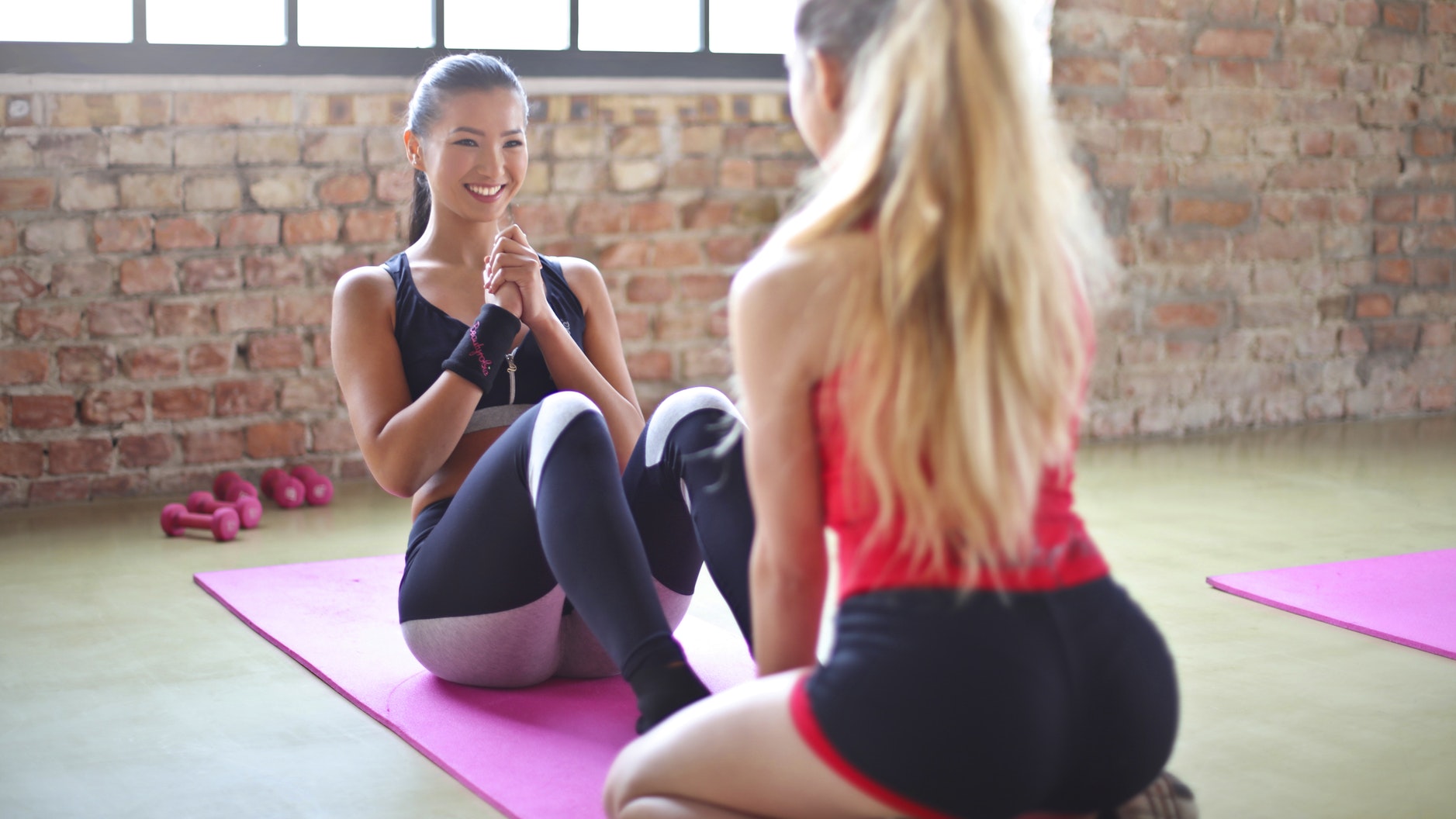Low Impact HIIT Workout: Gentle and Effective for All Ages
In the ever-evolving fitness world, High-Intensity Interval Training (HIIT) has emerged as a popular method for achieving quick and efficient results. However, traditional HIIT can be challenging for those with joint issues. It can also be a challenging workout for beginners who are easing into fitness due to its high-impact nature. Fortunately, there’s low impact HIIT workout – a gentler yet equally effective alternative to HIIT. How does it work?
This comprehensive guide will take a deep dive into the world of Low Impact HIIT. Let’s explore the following points:
- Understanding low-impact HIIT
- Health benefits of low-impact HIIT workout
- 10-minute low-impact HIIT workout for beginners
- Best low-impact HIIT workout to challenge your body safely
- Is a low-impact HIIT workout suitable for individuals over 50?

What Is Low Impact HIIT Workout?
The primary goal of a low-impact HIIT workout is to maintain a gentle exercise intensity. Even with lower intensity, you’ll gain benefits akin to traditional High-Intensity Interval Training (HIIT).
Unlike traditional HIIT, low-impact HIIT offers an alternative that minimizes strain on joints, muscles, and bones. It caters to individuals of all ages and fitness levels, welcoming beginners and those with joint issues or prior injuries.
Did you know? According to research, most people acknowledge the health advantages of physical activity. However, it is concerning that roughly 20% of individuals worldwide still need to meet the recommended daily amount. The World Health Organization suggests 150 min/week of moderate or 75 min/week of vigorous aerobic activity. Additionally, do muscle-strengthening exercises twice weekly.
Hence, low impact HIIT workout is a time-efficient and effective way to meet the recommended daily physical activity, offering short but intense workouts that burn more calories in less time.
What Is the Difference Between Low-Impact HIIT and HIIT Workouts?
High-Intensity Interval Training (HIIT) and Low-impact HIIT are two distinct approaches to interval training, each with their pros and cons. Check out this table below for a quick comparison:
| Aspect | High-Intensity Interval Training (HIIT) | Low Impact HIIT Workout |
| Intensity | Maximum effort during high-intensity intervals | Reduced intensity compared to traditional HIIT |
| Impact on Joints | High-impact movements place stress on joints | Minimizes stress on joints by keeping at least one foot grounded |
| Type of Exercises | Jumping, plyometrics, burpees, high-impact cardio moves, explosive exercises | Modified jumping jacks, knee raises, standing punches, low-impact lunges, bodyweight strength exercises |
| Who is it for? | Challenging for some, not suitable for everyone | More accessible to a broader range of individuals, including those with joint issues |
| Tailor Intensity | Challenging to customize intensity for beginners | Allows easier customization of intensity, adaptable to different fitness levels |
It is true that HIIT running is highly effective for enhancing strength, stamina, and endurance. The downside of it, it may exert significant stress on the joints. In low-impact exercises, you can replace high-impact jumps like burpees with a modified version like step-ups or knee tucks.
For example, instead of the explosive jump in a burpee, step back one foot at a time into a plank position. Then, return to standing, raising your knees towards your chest.
By making these minor adjustments, you can continue enjoying HIIT’s benefits without putting unnecessary stress on your body.
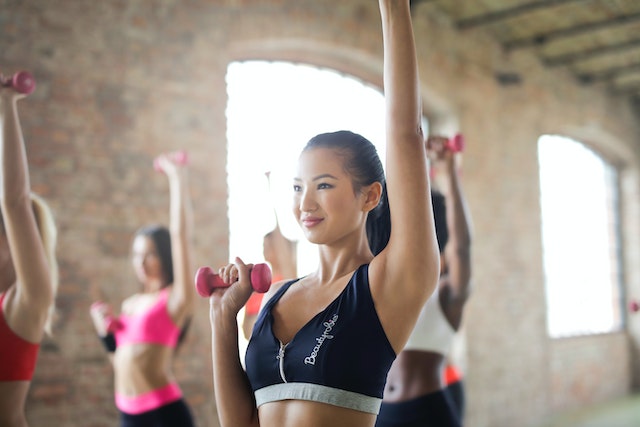
Health Benefits of Low Impact HIIT Workout
Low-impact HIIT workout offers health benefits, making them a versatile and accessible fitness option for many individuals. It can help:
- Improve heart health. Low-impact HIIT workouts offer significant benefits to cardiovascular health. Combining intense exercise and rest periods improves heart function and increases blood flow, resulting in a healthier heart.
- Enhance insulin sensitivity. Low-impact HIIT has demonstrated promising effects on insulin sensitivity, making it beneficial for individuals with prediabetes or type 2 diabetes. Regular workouts can improve how the body responds to insulin, helping to manage blood sugar levels.
- Burn calories. Despite being low-impact, HIIT workouts remain highly effective for burning calories and promoting weight loss. High-intensity intervals elevate the metabolic rate, increasing calorie expenditure and reducing body fat.
Furthermore, low-impact HIIT is suitable for individuals of all fitness levels. Beginners can ease into the routines to build strength and skills without risking injury. Moreover, individuals recovering from injuries or experiencing joint issues can still enjoy the benefits of a workout without exacerbating existing problems.
Are Low-Impact Hiit Workouts Good for Weight Loss?
For individuals carrying extra weight, one research found that high-impact exercises can stress joints and bones. The best low-impact HIIT workout for overweight people provides a safer starting point. This allows them to gradually build up to higher-impact workouts while reducing the risk of injury.
Is a Low-Impact HIIT Workout Suitable for Individuals Over 50?
Yes, a low-impact HIIT workout is highly suitable and beneficial for individuals over 50. As we age, our bodies may experience more joint issues, muscle stiffness, and physical limitations. Thus, this makes high-impact exercises potentially risky. Low-impact HIIT offers a gentler yet effective alternative that promotes overall health and well-being. Here are the key benefits of low impact HIIT workout for over 50:
- Joint-friendly
- Improves cardiovascular health
- Maintains muscle mass and strength
- Supports bone density
- Enhances balance and coordination
10-minute Low-Impact HIIT Workout for Beginners
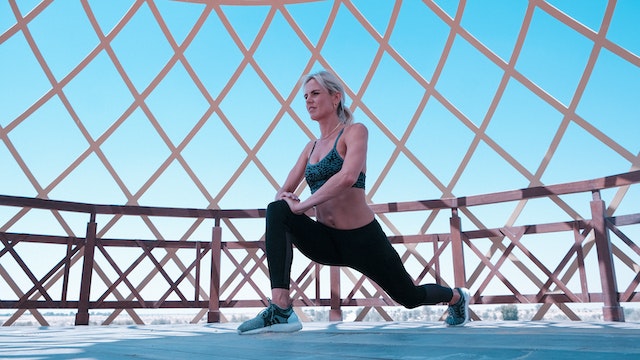
For those new to Low Impact HIIT, starting with a beginner-friendly routine is essential to build strength and stamina gradually. Here’s a simple 10 minute low impact HIIT workout for beginners to get you started:
1. Standing Leg Extensions
- Stand with feet hip-width apart and extend one leg forward, keeping it straight.
- Lower it back down and repeat with the other leg.
- Focus on engaging your core and maintaining balance.
2. Modified Push-Ups
- Get into a plank position on your knees or with your hands on an elevated surface. Find a sturdy elevated surface, such as a countertop, to work your upper body without straining your wrists.
- Lower your upper body towards the ground by bending your elbows.
- Push back up to the starting position.
3. Side Step With Arm Raises
- Stand with your feet together and arms resting by your sides.
- Step to the side with your right foot and raise both arms overhead.
- Return to the starting position and step to the side with your left foot while raising your arms overhead again.
- Continue alternating sides with controlled movements, engaging your lateral muscles.
4. Seated Shoulder Press (Dumbell workout)
- Sit on a chair or stability ball with your feet flat on the floor.
- Hold a light dumbbell in each hand at shoulder height.
- Press the dumbbells overhead, extend your arms fully, and lower them back down.
5. Punching
- Stand with feet slightly wider than shoulder distance apart, knees slightly bent, and engage your core for stability.
- Punch out one arm at a time in a controlled and intense manner. Keep a steady pace throughout the exercise to elevate your heart rate and engage your upper body muscles.
6. Seated Squat Position
- Sit on a chair or stability ball with your feet flat on the floor.
- Perform squats by standing up from the chair and sitting back down. Then, focus on using your leg muscles to lift your body weight.
7. Forearm Plank Hold
- Begin by placing your forearms on the ground, shoulder-width apart.
- Extend your legs straight back, supporting your body weight on your toes and forearms.
- Keep your body straight from head to heels, engaging your core muscles to maintain stability.
- Hold the plank position for the desired duration, aiming for 30 seconds or more.
- Breathe steadily and keep your body aligned throughout the exercise.
Note: Perform each exercise for 30 seconds, and then move on to the next exercise with a 15-second transition period.
Did you know? You don’t need to buy gym equipment to do low-impact exercises. Body weight movements offer various forms of exercises that can be designed for low impact HIIT workouts. Their convenience makes them ideal for home workouts or when equipment is unavailable.
Best Low-Impact HIIT Workout To Challenge Your Body Safely
There are other interesting low-impact HIIT exercises you can incorporate into your workout routine. You can diversify your training and keep you motivated on your fitness journey. Feel free to choose the best low-impact HIIT workout that you will enjoy:
- Chair step-ups. Use a sturdy chair or a step platform to perform step-ups. Then, alternate your legs to engage your lower body muscles, Doing this allows you to maintain a low impact on your joints.
- Tricep dips. Sit on the edge of a stable chair or bench, place your hands beside your hips, fingers pointing forward. Slide your hips off the chair and lower your body, bending your elbows. Push back up to work your triceps effectively.
- Seated Russian twists. Sit on the floor with your knees bent and feet flat on the ground. Hold a weight or medicine ball with both hands and twist your torso from side to side, engaging your core.
- Standing side leg lifts with a resistance band. Stand tall and place a resistance band around your ankles. Lift one leg to the side against the band’s resistance, engaging your outer thighs and glutes.
- Calf raises. Stand with feet hip-width apart, rise onto your toes, and lower back down. This exercise targets your calf muscles without stressing your joints.
- Plank-to-knee tuck. Start in a plank position and bring one knee toward your chest, then return to the plank position. Alternate legs to engage your core and work your hip flexors.
- Side-to-side hops. Stand with feet together and hop laterally from side to side, landing softly on the balls of your feet.
- Lateral shuffle. Start standing with feet hip-distance apart. Perform quick lateral shuffles to the right and left, engaging your leg muscles and cardiovascular system.
- Modified burpees. Perform a modified version of burpees. Just stepping back into a plank position instead of jumping and eliminating the jump at the end.
- Alternating heel touches. Lie on your back with your knees bent and feet flat on the floor. Reach towards your right heel with your right hand, then repeat on the left side, engaging your core throughout.
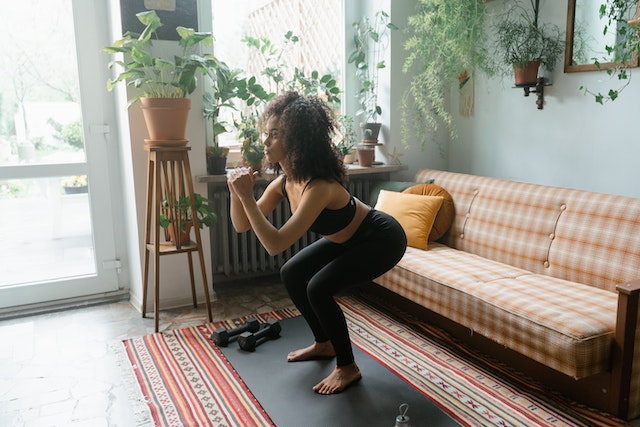
10-Minute Low-Impact HIIT Workout for Over 50
Looking for a quick and effective 10-minute low impact HIIT workout for over 50? This routine is designed to help you stay active and fit, providing a safe and joint-friendly exercise method.
Perform each exercise for 30 seconds and then move on to the next exercise with a 30-second transition (or rest) period.
1. Seated Arm Circles
- Sit comfortably on a chair or stability ball with feet flat on the floor and back straight.
- Extend arms to the sides at shoulder level, with a slight bend in elbows.
- Make small circles moving arms forward for 15 seconds, then backward for another 15 seconds.
- Continue alternating forward and backward arm circles for 30 seconds.
2. March or Jog
- For a march, lift your knees up high and swing your arms as you maintain a brisk pace.
- If you choose to jog, keep the same knee lift and arm swing but add a light bounce in your step.
- Perform this exercise for 30 seconds, choosing the intensity that suits you best.
3. Stationary Knee Lift
- Stand with your feet hip-width apart and hands on your hips.
- Lift one knee towards your chest and lower it back down.
- Repeat with the other knee.
- Continue alternating between knees for 30 seconds, keeping a steady pace and focusing on controlled movements.
4. Quick Punches (Left and Right)
- Stand firmly with your feet shoulder-width apart, shoulders back, and fists up.
- Jab with your right arm, extending it straight out in front of you, and then quickly return to the starting position.
- Continue punching to the left side for 30 seconds, engaging your core and controlling your movements.
- Switch sides and perform the same exercise, jabbing your left arm towards the right side for 30 seconds.
- Keep your movements powerful and steady, focusing on proper technique and form.
5. Low-Impact Cross-Body Punches
This exercise combines the right and left jabs in an alternating sequence.
- Jab with your right arm to the left side, then quickly switch and jab with your left arm to the right.
- Continue alternating jabs for 30 seconds, maintaining a strong and stable stance.
6. Modified Jumping Jacks
Finish the HIIT routine with this exercise.
- Stand with your feet together and arms relaxed by your sides.
- Step your right foot out to the side while simultaneously raising your right arm to shoulder height.
- Bring your right foot and arm back to the starting position. Then, step your left foot out to the side and raise your left arm.
- Keep alternating between the right and left sides, maintaining a steady motion. Remember to engage your core for stability throughout the exercise.
- Perform these modified jumping jacks for 30 seconds.
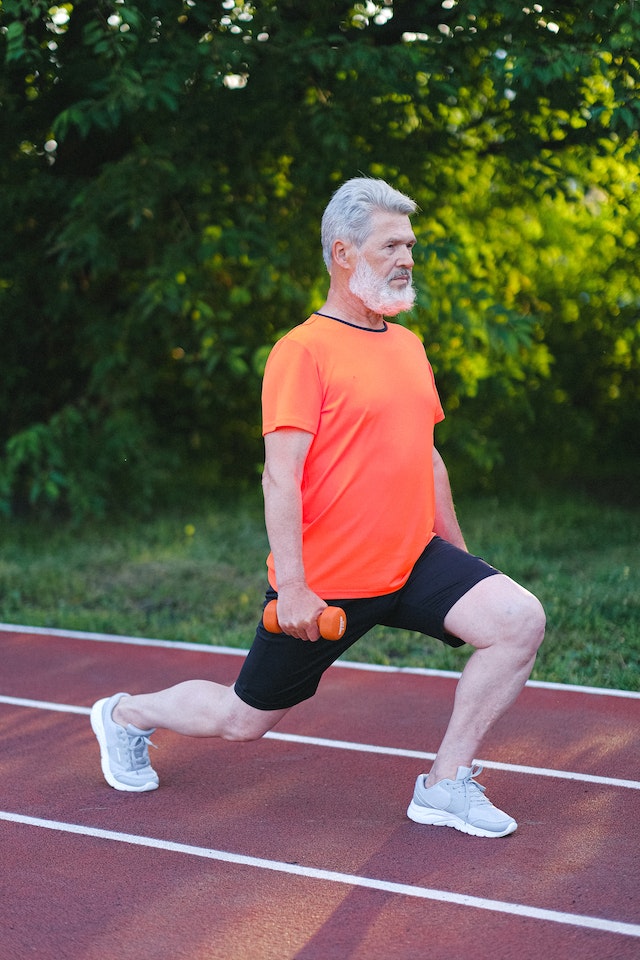
Note: Remember to perform a warm-up before starting your workout and a cool-down afterward to ease your muscles and prevent injury. If you have any concerns or medical conditions, consult a healthcare professional before beginning any new exercise routine.
Start your Low Impact HIIT journey today!
Beginner or experienced, young, or old, low impact HIIT is your ticket to a stronger, vibrant you. It is a versatile and efficient workout option that reduces the risk of injuries. Embrace this gentle fitness regimen and savor its benefits to your physical and mental well-being.
Start with ModernFit today and make the most of this effective, gentle fitness option for all ages. Your body will thank you for it!

